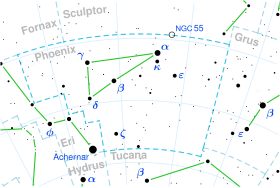Psi Phoenicis
| Observation data Epoch J2000 Equinox J2000 | |
|---|---|
| Constellation | Phoenix |
| Right ascension | 01h 53m 38.74103s[1] |
| Declination | −46° 18′ 09.6048″[1] |
| Apparent magnitude (V) | 4.41[2] (4.3 - 4.5[3]) |
| Characteristics | |
| Evolutionary stage | asymptotic giant branch[4] |
| Spectral type | M4III[5] |
| U−B color index | +1.71[2] |
| B−V color index | +1.59[2] |
| Variable type | SR[3] |
| Absolute magnitude (MV) | −0.71[5] |
| Details | |
Gyr | |
SAO 215696 | |
| Database references | |
| SIMBAD | data |
Psi Phoenicis (ψ Phoenicis) is a star in the constellation Phoenix. Its apparent magnitude varies from 4.3 to 4.5 with a period of about 30 days[3] and it is approximately 342 light years away based on parallax.[1]

Psi Phoenicis is a
In 2001, Psi Phoenicis was observed by the
By having directly measured distance, radius and luminosity, Psi Phoenicis was included in a list of 34 well characterized stars to be used as a reference. This program made the first measurement of the metallicity of Psi Phoenicis, showing it is a metal-poor star with only 5% the amount of iron of the Sun ([Fe/H] = −1.24±0.39). This value has a large uncertainty due to the difficulties in modeling the spectra of cool stars, which have strong molecular absorption. The evolutionary state and poorly constrained metallicity result in an uncertain mass of 1.0±0.4 M☉.[9][15] Assuming a metallicity closer to solar, a mass of 1.3±0.2 M☉ is derived.[7]
Psi Phoenicis is considered a single star, and has no known companions.
References
- ^ S2CID 18759600. Vizier catalog entry
- ^ Bibcode:2002yCat.2237....0D.
- ^ Bibcode:2009yCat....102025S.
- ^ doi:10.1086/116239.
- ^ S2CID 119257644. Vizier catalog entry
- S2CID 119231169.
- ^ S2CID 18340833.
- ^ S2CID 118335709.
- ^ S2CID 119241541.
- S2CID 118697261.
- ^ "/ftp/cats/more/HIP/cdroms/cats". Centre de Données astronomiques de Strasbourg. Strasbourg astronomical Data Center. Retrieved 15 October 2022.
- doi:10.1086/152371.
- S2CID 15358380.
- S2CID 1586125.
- S2CID 53391939.
- S2CID 14878976.

